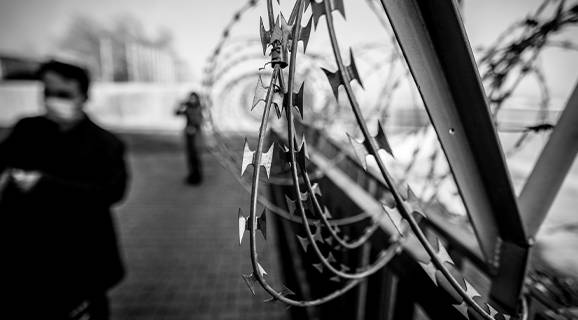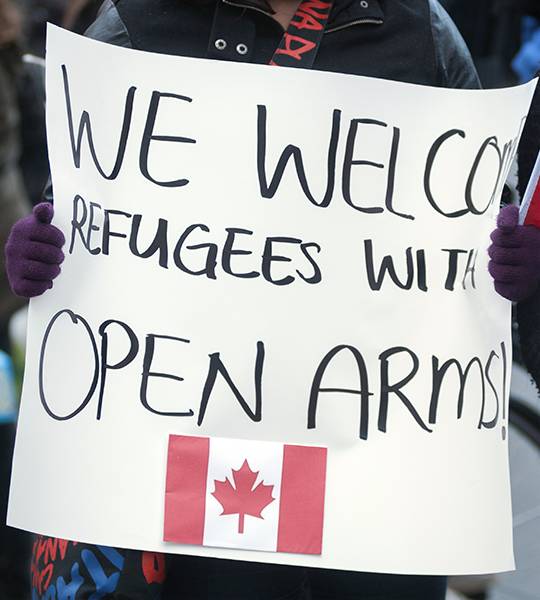
Immigration
and Refugee Board
Canada is a signatory State to:
1951 convention Relating to the Status of Refugees/1967 Protocol Relating to Status of Refugees, 1984 Convention Against torture and other Cruel, inhuman or degrading treatment or punishment, 1966 International covenant on civil and political rights,
Second Optional Protocol to the international covenant on civil and political rights aiming at the abolition of death penalty.
Canada binds itself to implement the provisions of the international instruments to which it is a signatory state by passing or amending its laws and regulations.
Immigration and Refugee Protection Act has passed by the Parliament of Canada to create a high-level framework detailing the goals and guidelines the Canadian government has set with regard to immigration to Canada by foreign residents.
Part 3 of the Act deals with issues relating to Refugees.
IRPA divides refugees into two categories of Convention Refugees and Person in need of Protection.
Convention Refugee
Section 96 of Immigration Refugee Protection Act specifically defines a convention refugee as:
“A person who by reason of a well-founded fear of persecution for reasons of race, religion, nationality, membership in a particular social group or political opinion,
- Is outside each of their countries of nationality and is unable or, by reason of that fear, is unwilling to avail themselves of the protection of each of those countries, or
- not having a country of nationality, is outside their country of former habitual residence and is unable or, by reason of that fear, unwilling to return to that country”.


Grounds of persecution is called Nexus.
- Race,
- Religion,
- Nationality,
- Political Opinion, or
- Membership of a particular social group
There is no specific definition for Persecution neither in the Convention nor IRPA. However Canadian case law has not only labelled specific behaviours as instances of persecution, but also has gone some distance toward identifying general hallmarks that must be present, or criteria that must be met, in order for actions or omissions to constitute persecution. To view different types of persecution click here.
In order to prove well found fear of persecution claimant needs to prove that he/she has a subjective fear of persecution and the fear has an objective basis which means that the fear is both genuine and objectively justifiable.
Person in need of protection
Section 97 describes persons in need of protection as:
“Persons in Canada whose removal to their country or countries of nationality or, if they do not have a country of nationality, their country of former habitual residence, would subject them personally
- To a danger, believed on substantial grounds to exist, of torture within the meaning of Article 1 of the Convention Against Torture; or
- To a risk to their life or to a risk of cruel and unusual treatment or punishment if
- The person is unable or, because of that risk, unwilling to avail themselves of the protection of that country,
- The risk would be faced by the person in every part of that country and is not faced generally by other individuals in or from that country,
- The risk is not inherent or incidental to lawful sanctions, unless imposed in disregard of accepted international standards, and
- The risk is not caused by the inability of that country to provide adequate health or medical care.”
Under a number of conventions, persons in need of protection are persons whose removal to their country of origin would subject them personally to:
- A danger of torture,
- A risk to their life, or
- A risk of cruel and unusual treatment or punishment
In order for a claimant seeking protection five conditions must be met
- No state protection
- There is No Internal Flight Alternative
- The risk is not faced GENERALLY
- The sanction is not lawfulThere is no ability to provide health or medical care
In order to claim refugee status in Canada, your claim should be referred to Immigration and refugee board of Canada which approves or denies your claim.
Claim of refugee status is made inside Canada in 2 ways
- Making a refugee claim at any port of entry
- Making a refugee claim with Immigration Refugee Citizenship of Canada
You can make a claim for refugee protection at any port of entry when you arrive in Canada.
This means an airport, seaport or land border.
A border services officer will ask you to complete the required application forms when you arrive. Normally, you’ll complete the forms at the port of entry.
While at the port of entry, the officer will also:
- Ask you questions about your situation
- Collect your documentation and proof of identity
- Take your fingerprints and photo
If the officer decides your refugee claim is eligible The officer will give you:
- A Refugee Protection Claimant Document, which will help you get access to the Interim Federal Health Program and other services in Canada
- A confirmation of referral letter, which confirms your claim has been referred to the Immigration and Refugee Board of Canada (IRB)
- A Basis of Claim form:
The purpose of this form is to present your refugee protection claim to the Refugee Protection Division (RPD). In the BOC Form, you will give details about yourself (your identity, family, documents and travel history) and about why you are claiming refugee protection in Canada. - Instructions about completing your medical exam
You have 15 calendar days to complete the Basis of Claim form and submit it to the IRB’s Refugee Protection Division office shown on your confirmation of referral letter.
If the officer tells you to come back to the port of entry or an inland office for an interview
The officer will give you:
- An information pamphlet
- An acknowledgement of claim letter (which will help you get access to the Interim Federal Health Program and other services in Canada.
You make your claim inside by submitting it to Immigration and Refugee Citizenship Canada.
Benefits of claiming refugee status inside Canada
- Using legal services provided by professional legal counsels
To make a refugee claim, you need to submit a complete application from inside Canada. Your application will help IRCC understand: - Your background
- Your family
- Why you want to make a refugee claim by submitting Basis of Claim
The information you are providing must be in conformity with information you have already provided in your Generic Application, Schedule A, before coming to Canada.
Moreover, you are expected to provide information in regards to your background, and additional information.
After submitting the claim, claimant or his/her counsel will receive letter of Acknowledgement and a letter to refer claimant to a doctor for medical examination.
Appointment with a doctor is necessary in order to use Interim Federal Health Program.
There will be two appointments that claimant needs to attend before his/her claim is referred to Immigration and Refugee Board of Canada for final decision.
At first interview claimant needs to hand over his/her passport. Claimant will be called for another interview which is called Eligibility Interview. Then the claim will be referred to IRB.
During waiting period claimant will be issued a work permit and a study permit at no cost.
Exclusion Clauses
Section 98 of IRPA and articles 1E and F of UN convention on Refugee Status do not consider certain people as people eligible for seeking protection as refugee.
Article E states that: “This Convention shall not apply to a person who is recognized by the competent authorities of the country in which he has taken residence as having the rights and obligations which are attached to the possession of the nationality of that country”.
Article F stipulates that: “The provisions of this Convention shall not apply to any person with respect to whom there are serious reasons for considering that:
- He has committed a crime against peace, a war crime, or a crime against humanity, as defined in the international instruments drawn up to make provision in respect of such crimes;
- He has committed a serious non-political crime outside the country of refuge prior to his admission to that country as a refugee;
- He has been guilty of acts contrary to the purposes and principles of the United Nations.”
In addition, there are grounds set out in section 108 of IRPA for rejecting claim for refugee protection.
Section 108 stipulates that: : “A claim for refugee protection shall be rejected, and a person is not a Convention refugee or a person in need of protection, in any of the following circumstances:
- The person has voluntarily reavailed themself of the protection of their country of nationality;
- The person has voluntarily reacquired their nationality;
- The person has acquired a new nationality and enjoys the protection of the country of that new nationality;
- The person has voluntarily become re-established in the country that the person left or remained outside of and in respect of which the person claimed refugee protection in Canada; or
- The reasons for which the person sought refugee protection have ceased to exist.”
Immigration and Refugee Board of Canada
The Immigration and Refugee Board of Canada (IRB) which is Canada’s largest independent administrative tribunal, is responsible for making decisions on immigration and refugee matters. The IRB decides, among other responsibilities, who needs refugee protection among the thousands of claimants who come to Canada annually.
The Immigration and Refugee Board consists of the Refugee Protection Division, the Refugee Appeal Division, the Immigration Division and the Immigration Appeal Division.
Refugee Protection Division
The “Refugee Protection Division (RPD) of the Immigration and Refugee Board of Canada (IRB) hears and decides claims for refugee protection made in Canada.
Refugee protection can be conferred in Canada if the RPD determines that the claimant meets the United Nations definition of a Convention refugee, which has been incorporated into Canadian law, or that the claimant is a person in need of protection. Refugee Protection Division is governed by Refugee Protection Division Rule.
Refugee Appeal Division (RAD)
RAD hears appeals after a claim for refugee protection is denied by the Refugee Protection Division (RPD). You may be permitted to appeal if the RPD has rejected your claim. The RAD can also decide an appeal made by the Minister on a positive RPD decision. The RAD is separate and independent from the RPD and is governed under RPD’s rules.

There are two steps involved in appealing to the RAD:
- Filing appeal
You must file your notice of appeal to the RAD no later than 15 days after you receive the written reasons for the RPD’s decision. You must provide three (3) copies of your notice of appeal to the RAD Registry in the regional office that sent your RPD decision.
- Completing appeal
You must complete your appeal by providing your appellant’s record to the RAD no later than 30 days after you receive the written reasons for the RPD’s decision. You must provide two (2) copies of your appellant’s record to the RAD Registry in the regional office that sent you your RPD decision.
Immigration Appeal Division
There are several types of appeals that are heard by the Immigration Appeal Division (IAD) of the IRB, to challenge decisions:
- appeals of family class sponsorship applications – for example, of spouses – refused by officials of Immigration, Refugees and Citizenship Canada (IRCC);
- appeals of removal orders made against permanent residents, Convention refugees and other protected persons, and holders of permanent resident visas;
- appeals by permanent residents who have been found by a visa officer outside of Canada not to have fulfilled their residency obligation; and
- appeals by the Minister of Public Safety (representing the Canada Border Services Agency) of favourable decisions at admissibility hearings by the IRB’s Immigration Division.

How Creditability of claims are assessed
Section 170 of IRPA allows Refugee Protection Division not to be bound by any legal or technical rules of evidence. RPD is allowed to receive and base its decision on evidence that is adduced in the proceedings and considered credible or trustworthy in the circumstances.
Section 171 of IRPA bans RPD or Refugee Appeal Division of IRB to reject evidence simply because it is hearsay (Guthrie v. Canada P12).
In assessing credibility, the Board may consider matters such as inconsistencies, contradictions and omissions from the evidence, specialized knowledge, inferences, implausibilities, documentary evidence and the claimant’s demeanour at the hearing.
Findings of fact, and consequently, the determination as to whether a claimant’s evidence is credible, are made on a balance of probabilities, or whether something is more likely than not.
In the context of the applicant’s responsibility to prove facts in support of his/her claim, the term “standard of proof” means the threshold to be met by the applicant in persuading the adjudicator as to the truth of his/her factual assertions.
It is not appropriate to apply the benefit of the doubt where the claimant’s allegations run contrary to generally known facts or the available evidence.
Handbook on Procedures and Criteria for Determining Refugee Status under the 1951 Convention and the 1967 Protocol relating to the Status of Refugees is one of the comprehensible sources members of Immigration and Refugee Board may use in order to determine if a claim for refugee is credible.


